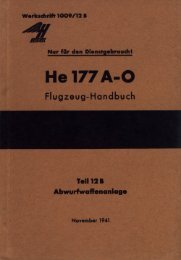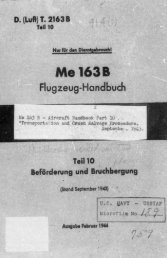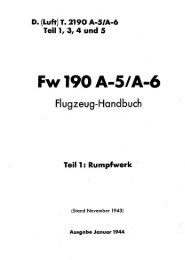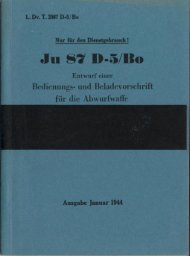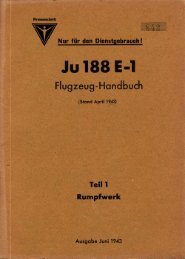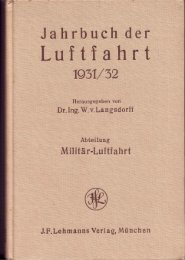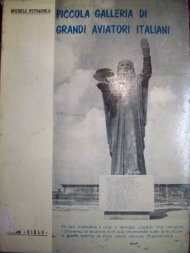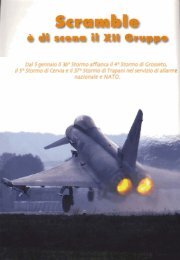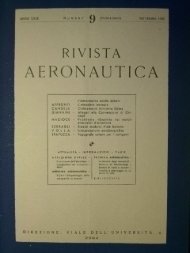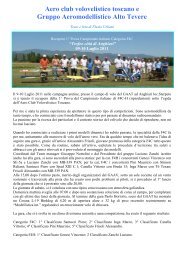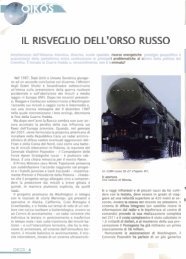FLY-LOW - AVIA
FLY-LOW - AVIA
FLY-LOW - AVIA
Create successful ePaper yourself
Turn your PDF publications into a flip-book with our unique Google optimized e-Paper software.
Air<br />
to<br />
Air Space Division and Separation of ATC Duties<br />
Tower? Center? Or Flight Service?<br />
Do you know who the first Air Traffic<br />
Controller was? Wilbur Wright, as he<br />
yelled “It’s clear - go ahead Orville!”<br />
Although there are three<br />
divisions of Air Traffic Control, most<br />
people only see Towers – and from TV<br />
and movies they know about radar, but<br />
they think that if you are an Air Traffic<br />
Controller it follows that you must work<br />
at an airport.<br />
New pilots are taught that<br />
there are three major divisions of Air<br />
Traffic –Air Route Traffic Control Centers<br />
(ARTCC or Center), Air Traffic Control<br />
Towers (Tower) which may also have<br />
an Approach or Departure Control,<br />
and Flight Service Stations (FSS)– also<br />
known as Radio. Improved technology<br />
is changing these definitions and many<br />
Approach/Departure control facilities are<br />
completely separate from the Towers, and<br />
not necessary located at the airport they<br />
serve.<br />
The Airspace above us in the<br />
United States is divided up into areas<br />
that are either controlled or uncontrolled.<br />
Uncontrolled airspace is everything that<br />
is not designated as something else, and<br />
it is one of the most precious things that<br />
pilots here in the United States have<br />
access.<br />
The largest areas of uncontrolled<br />
airspace are out west – which is where<br />
students come from all over the world to<br />
learn to fly, and many European pilots<br />
come to build their hours so they can<br />
apply for jobs with air taxis and airlines<br />
once they return home.<br />
The U.S. was the first country to develop<br />
a National Airspace System (NAS), and in<br />
addition to our own people, the Air Traffic<br />
Control academy in Oklahoma City has<br />
taught hundreds of classes in the basics<br />
of the NAS to representatives from other<br />
countries who then take that knowledge<br />
home. By doing this, the U.S. not only<br />
promotes a system whereby any pilot<br />
knows what to expect no matter where<br />
they fly, but they also have established<br />
that English is the language of Aviation<br />
throughout the free world.<br />
Before the existence of Air Traffic<br />
Control Towers (ATCT or Tower), early<br />
controllers used flags and lights to signal<br />
landing and departure instructions to<br />
pilots. In 1930, the first airport to have<br />
a radio-equipped control tower was built<br />
in Cleveland. The Towers are always<br />
located at airports wherein the landing,<br />
departing and overflight traffic has grown<br />
to the extent that accidents are likely<br />
without someone on the ground keeping<br />
an eye on the sky. Smaller airports<br />
rely on pilots to tune to a common radio<br />
frequency (UNICOM) and announce their<br />
intentions. Busier airports may also<br />
have an Approach/Departure Control colocated<br />
with the Tower. These structures<br />
“own” the airspace immediately above<br />
and surrounding the airport.<br />
Air Route Traffic Control Centers<br />
- The Centers cover huge areas, usually<br />
several states wide. These huge facilities<br />
have 40 or 50 radar scopes and employ<br />
about 300 controllers. Their airspace is<br />
divided both geographically and into high<br />
altitude and low altitude sectors.<br />
Have you looked on aviation charts and<br />
noticed that the Center boundaries are<br />
oddly shaped? That’s partially because<br />
they were not all created at once. A<br />
consortium of commercial airlines and<br />
airport operators established the first<br />
three Centers, Cleveland, Chicago and<br />
Newark during late 1935 through June<br />
1936. The Bureau of Air Commerce, within<br />
the Department of Commerce (DOC), took<br />
over their operation when it assumed<br />
responsibility for En Route ATC in July<br />
1936. As air traffic density moved west,<br />
new Centers were created to manage the<br />
flows. Each time, the protected airspace<br />
was built primarily around the areas<br />
containing a dense population of aircraft.<br />
Ground author@rosemariekern.com<br />
Early en route controllers tracked<br />
aircraft positions on maps and blackboards<br />
using little boat-shaped weights called<br />
“shrimp boats.” There was no direct<br />
communication capability between<br />
controllers and aircraft at the time, so<br />
they used telephones to stay in touch<br />
with airline dispatchers, airway radio<br />
operators, and airport traffic controllers,<br />
who also fed information to the en route<br />
controllers and relayed their instructions<br />
to pilots.<br />
Today each Center handles several states<br />
traffic, and advances in technology have<br />
increased the ability of the Controllers to<br />
more accurately determine the placement<br />
of aircraft in their airspace. The latest<br />
mergence of radar, satellite and computer<br />
functions used by the Centers is known as<br />
the En Route Automation Modernization<br />
(ERAM) computer. The accuracy of this<br />
system allows closer, more accurate<br />
placement of aircraft in our increasingly<br />
crowded airspace.<br />
The Automated Flight Service Station<br />
(AFSS) handles a diversity of pilot needs.<br />
The physical structure can be located<br />
at an airport, but modern technology<br />
has removed that requirement since<br />
everything the AFSS does is by phone<br />
or radio. Flight Service briefs pilots on<br />
Clarksville Municipal<br />
Airport<br />
Discount Fuel Pricing<br />
EVERYDAY<br />
Aircraft Maintanence<br />
86<br />
29<br />
on Field<br />
call<br />
479.705.1250<br />
Clarksville, Arkansas<br />
DATE: November 29, 2011<br />
AD #: 2011-25-51<br />
Emergency airworthiness directive<br />
(AD) 2011-25-51 is sent to owners and<br />
Kern has operators worked in of Air Traffic Control for 26 years<br />
certain Continental Motors, Inc. (CMI)<br />
Models TSIO-520, TSIO-550-K, TSIOF-<br />
550K,<br />
engines.<br />
and IO-550-N reciprocating<br />
By Rose Marie Kern<br />
preflight conditions including weather,<br />
hazardous conditions and anything<br />
significant they may encounter on their<br />
flight. They take flight plans and they<br />
monitor the progress of VFR aircraft<br />
(aircraft flying uncontrolled below 18,000<br />
feet). They also are the initiators of<br />
search and rescue should a VFR aircraft<br />
become overdue, act as an interface with<br />
both the other branches of ATC and<br />
related government agencies, such as<br />
Customs, Homeland Security, and the<br />
military. Other duties of Flight Service<br />
include Flight Watch, a service to update<br />
pilots on weather enroute; Broadcast,<br />
recording weather and other information<br />
that is available by phone or radio; and<br />
Flight Data.<br />
We live in exciting times right now<br />
because the FAA is in the process of<br />
revising the entire ATC system. In<br />
2005 this process began with the<br />
FAA Administrational offices being<br />
redistributed along regional lines. The<br />
first of the field operations to adjust<br />
their boundaries and begin consolidation<br />
was Flight Service in 2006, shortly after<br />
being taken over by Lockheed Martin<br />
Information Technologies.<br />
Within the next twenty years you will see<br />
the Approach/Departure controls being<br />
completely separated from the airports<br />
they serve and many will be housed with<br />
the Centers. The Center boundaries will<br />
be changing as well.<br />
Currently the government is working<br />
to implement the Next Generation Air<br />
Transport System, which will primarily<br />
affect the airlines and executive aircraft,<br />
and dramatically change ATC as we know<br />
it. For more information go to www.jpdo.<br />
aero.<br />
Editor’s Note: Rose Marie Kern has<br />
worked in ATC since 1983. If you have<br />
questions you can contact her at author@<br />
rosemariekern.com.<br />
FAA News<br />
Background<br />
This emergency AD was prompted by<br />
5 reports received of fractures in starter<br />
adapter shaftgears in certain part<br />
number (P/N) CMI starter adapters. This<br />
condition, if not corrected, could resultin<br />
failure of the starter adapter gear shaft,<br />
leading to an inoperable oil scavenge<br />
pump and enginein-flight shutdown.<br />
Relevant Service Information<br />
We reviewed CMI Mandatory Service<br />
Bulletin (MSB) No. MSB11-4, dated<br />
November 23,2011. The MSB describes the<br />
affected starter adapters, and describes<br />
what starter adapters areeligible for<br />
installation.<br />
FAA’s Determination<br />
We are issuing this AD because we<br />
evaluated all the relevant information<br />
and determined the unsafe condition<br />
described previously is likely to exist or<br />
develop in other products of the same type<br />
design.<br />
AD Requirements<br />
This AD requires replacing affected CMI<br />
starter adapters with starter adapters<br />
eligible for installation.<br />
HOW TO BE COME AN AIRCRAFT<br />
MECHANIC<br />
I’m a US Citizen. What requirements<br />
UNICOM 122.8 AWOS 133.32<br />
5000’ X 75’ RUNWAY<br />
VOR 111.6 (MON)<br />
LOCATED 4.7 MILES SOUTHEAST OF AIRPORT Learn<br />
Lowest Fuel Prices - 24 Hour<br />
for 100 LL & Jet A<br />
Credit Card System<br />
HOURS: 7:30 A.M.-4:30 P.M. MON-FRI.<br />
Monticello Airport<br />
8 January 2012 • www.fly-low.com www.fly-low.com •January 2012 9<br />
KLLQ<br />
To Fly<br />
870-367-4450<br />
must I meet to get a mechanic’s<br />
certificate?<br />
You must be<br />
at least 18 years old;<br />
able to read, write, speak, and<br />
understand English.<br />
You must get 18 months of practical<br />
experience with either power plants<br />
or airframes, or 30 months of practical<br />
experience working on both at the same<br />
time. As an alternative to this experience<br />
requirement, you can graduate from an<br />
FAA-Approved Aviation Maintenance<br />
Technician School.<br />
You must pass three types of tests;<br />
a written examination<br />
an oral test<br />
a practical test<br />
I’m not a US Citizen, and I live<br />
outside the United States. How<br />
do I get a mechanic’s certificate?<br />
You must meet all the requirements listed<br />
above for United States citizens. You must<br />
also meet the following requirements:<br />
Demonstrate you need a mechanic<br />
certificate to maintain U.S.-registered<br />
civil aircraft and you are neither a U.S.<br />
citizen nor a resident alien.<br />
Show the examiner your passport.<br />
Provide a detailed statement from your<br />
employer saying what specific types of<br />
maintenance you preformed on each<br />
aircraft, and how long you performed it.<br />
Provide a letter from the foreign<br />
airworthiness authority of the country in<br />
which you got your experience, or from an<br />
advisor of the International Civil Aviation<br />
Organization (ICAO), validating your<br />
maintenance experience. ELLIS FIELD<br />
Make sure all the documents you provide<br />
FULL SERVICE JET A<br />
COURTESY CAR<br />
PILOT LOUNGE<br />
MONTICELLO, AR<br />
X<br />
are signed and dated originals.<br />
Pay the fee for the document<br />
review.<br />
What if I can’t meet<br />
the English language<br />
r e q u i r e m e n t s ?<br />
We may waive the language<br />
requirement if you live outside<br />
the United States. We would stamp your<br />
certificate “Valid only outside of the U.S.”<br />
Do I need any other certificate<br />
to work on avionics equipment?<br />
If you have an airframe certificate you<br />
don’t need any other certificate, but you<br />
must be properly trained and qualified<br />
and have the proper tools and equipment.<br />
You can even work on avionics equipment<br />
without a certificate if you have avionics<br />
repair experience from the military or<br />
from working for avionics manufacturers<br />
and related industries.<br />
How do I get a repairman’s certificate?<br />
To get a repairman’s certificate, you must<br />
MENA AIRCRAFT ENGINES, INC.<br />
Lycoming ~ Continental<br />
• New Limits, Balanced, Overhauled Aircraft Engines<br />
KLLQ • Engine Removal, Installation, Annuals, Engine<br />
Removal, Installation, and Annuals Available<br />
The engine you want and<br />
Professionalism you deserve!!!<br />
Robert Smith Jr., President • 103 Aviation Lane, Mena, Arkansas 71953<br />
Mike Guinn - Shop manager<br />
Email: Rbsmith@cswnet.com<br />
Call or visit website today<br />
for a detailed quote:<br />
FAX 918.272.6501<br />
www.menaaircraftengines.com<br />
be recommended by a repair station,<br />
commercial operator, or air carrier. You<br />
must<br />
be at least 18 years old;<br />
be able to read, write, speak, and<br />
understand English<br />
be qualified to perform maintenance on<br />
aircraft or components<br />
be employed or a specific job requiring<br />
special qualifications by an FAA-certified<br />
Repair Station, commercial operator, or<br />
air carrier.<br />
be recommended for the repairman<br />
certificate by your employer<br />
have either 18 months practical<br />
experience in the specific job or complete a<br />
formal training course acceptable<br />
to FAA.<br />
479.394.7688<br />
FAA CRS# S9QR340N




